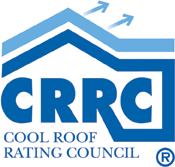What's So Cool About Cool Roofs?
Innovative technology allows designers to choose a cool roof from myriad colors and materials for a variety of roofing applications.
![]() Continuing Education
Continuing Education
Use the following learning objectives to focus your study while reading this month’s Continuing Education article.
Learning Objectives - After reading this article, you will be able to:
- Define a cool roof.
- Describe the benefits of specifying a cool roof.
- Identify codes or green building programs that either require or offer credit for cool roofs.
- Describe the options for cool roofing materials.
Hip, square, flat, or pointed, cool roof products are being specified by architects to save energy, satisfy building codes and meet client expectations for comfort, cost and aesthetics. Cool roofs can be selected from a wide variety of materials and colors and can be applied to virtually any building or roof slope in any location. It is intuitive that the extent of the benefits will correlate to the building's location, type and use, as well as to the specific radiative properties of the selected roofing product. However, what may be counter intuitive is the broad range of locations in which cool roofs are proving to be a viable energy efficiency measure. Simply put, cool roofs are roofing products that integrate materials with greater spectral reflectance than their traditional, non-cool counterparts, and thereby minimize the transfer of heat to the building below. This is true for a broad range of product types, colors, textures and roof slope applications.
COOL ROOFS 101
A CLOSER LOOK AT RADIATIVE PROPERTIES
The two radiative properties that characterize cool roofs are solar reflectance and thermal emittance (see Figure on p. 2). A cool roof minimizes the solar heat gain of a building by first reflecting incoming radiation and then by quickly re-emitting the remaining absorbed portion. As a result, the cool roof stays cooler than a traditional roof of similar construction.
When sunlight hits an opaque surface, some of the energy is reflected. The measured fraction of solar energy that is reflected by a roofing material's surface is called solar reflectance, or albedo. Solar reflectance is measured on a scale from 0 to 1. High albedo, more reflective surfaces stay much cooler than low albedo, less reflective surfaces. So the higher the solar reflectance value the "cooler" the roof. Energy that is not reflected by the roof is potentially absorbed by it; this is where thermal emittance comes into play.
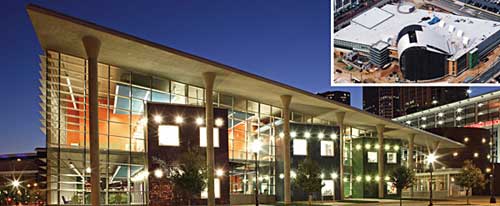
|
A cool roof slopes from one end of ImaginOn: The Joe & Joan Martin Center in North Carolina to the other. Construction photo in the inset shows the many ways this roofing system was installed to accomodate skylights, slopes and a flat roof surface. This project received a LEED-NC Silver rating in 2006 receiving the LEED 7.2 credit for the mitigation of heat island effects. Click on inset image to see larger details. Photos courtesy of Gantt Huberman Architects, PLLC. Photography (left) by Tom Kessler Photography. |
Â
Thermal emittance is the relative ability of the roofing material to re-radiate absorbed heat as invisible infrared light (relative to a black body radiator). This absorbed heat will either be gradually or quickly re-radiated away from the roof; the quicker the better because the longer the heat is trapped at the surface of the roof the more likely it is to penetrate the building below. Thermal emittance is also measured on a scale from 0 to 1, so a roofing material with a higher thermal emittance will re-emit absorbed thermal energy more quickly than a material with a low emittance and will result in a "cooler" roof.
Though most roofing materials have a fairly high thermal emittance, in order to accurately determine a roofing product's "coolness," or its ability to shield the building beneath it from heat, both solar reflectance and thermal emittance must be measured. It is important to note that it is possible for a roofing product to have a very high emittance value and a reflectance value ranging from very high to very low, or vice versa, although such products would not typically be considered "cool" roofs. A high emittance value alone will not result in a "cool" roof nor will a high reflectance value alone. The Solar Reflectance Index can be a useful toolfor determining the overall thermal properties of a roofing product.
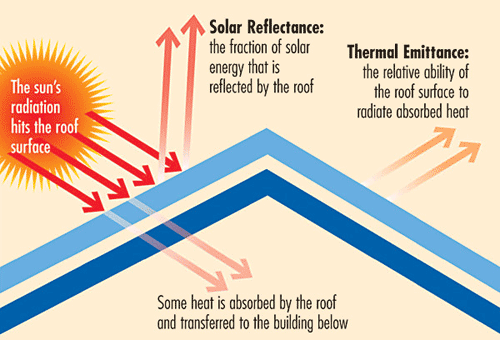 |
This diagram shows solar radiation on a roof surface. Image courtesy of Cool Roof Rating Council |
SOLAR REFLECTANCE INDEX (SRI)
Codes, standards and programs that specify cool roofing requirements may also reference an additional calculated value,the Solar Reflectance Index (SRI). SRI allows actual measured solar reflectance and thermal emittance values to be combined into a single value by determining how hot a surface would get relative to standard black and standard white surfaces.
 The standard black roofing material has a high emittance value (90 percent) but a low reflectance value (5 percent). This creates a hot roof surface because even though the emittance is high, there isn't enough reflectance to help cool the roof. As such, the standard black roof is given an SRI value of 0.
The standard white roofing material is highly reflective (80 percent) and has the same emittance as the standard black surface (90 percent). Its surface is much cooler and the standard white roof is assigned an SRI value of 100. Like solar reflectance and thermal emittance, a higher SRI value is synonymous with a cooler roof.
Calculating SRI
Lawrence Berkeley National Laboratory hosts an easy-to-use SRI calculator on their website. All that is required is the solar reflectance and thermal emittance values and the tool will calculate the SRI. The calculator is located at: coolcolors.lbl.gov/assets/docs/SRI%20Calculator/SRI-calc10.xls
COOL ROOFS EQUATE TO BIG BENEFITS TO THE OWNER AND THE ENVIRONMENT
When properly installed and maintained, cool roofs provide numerous benefits that contribute to the health of a community, to the occupants of the building and to the owner's pocket book.
Among the benefits to the building occupants and owner are:
Improved comfort because the building's interior is subject to less thermal flux and stays cooler during the warm season.
Reduced energy costs because of reduced air-conditioning.
Longer AC unit life resulting from decreased air-conditioning loads.
Increased roof longevity due to reduced thermal flux.
Cool roofs are distinguished among energy conservation measures because of the many environmental benefits they can provide. This is attributed to the fact that they combat the urban heat island effect. The urban heat island effect is a relatively newly identified phenomenon that is characterized by a measured increase in the ambient air temperature in cities over their surrounding rural areas. This is due to roofs and other non-reflective surfaces that absorb and trap solar radiation - or heat. The excess trapped heat is gradually released to the ambient air throughout the day, evening and nighttime hours, warming up the urban core round the clock. The effect results in an environmentally negative and spiraling impact, including:
Increased demand for air-conditioning in both air-conditioned and un-conditioned buildings, thus increasing the potential for the installation of air-conditioners in buildings that currently don't need them.
Increased greenhouse gas emissions that contribute to global warming, released as a result of fossil fuel generated electricity to power air conditioners.
Increased smog formation.
AIR QUALITY AND CLIMATE CHANGE: HOW COOL ROOFS HELP
Through mitigation of the urban heat island effect with the reduction of ambient air temperatures, cool roofs also improve air quality. Smog is created by photochemical reactions of air pollutants, and these reactions increase at higher temperatures. In Los Angeles alone, mitigation measures that reduce the average air temperature by 3K (5 °F) could yield a 12 percent reduction in smog (ozone) worth $360 M/year.i Lower ambient air temperatures and the subsequent improved air quality also result in a reduction in heat-related and smog-related health issues, including heat stroke and asthma. In addition to the reduction of greenhouse gas emissions such as CO2, by conserving electricity for air conditioning cool roofs reduce the emission of NO2 and SO2 particulates from power plants.
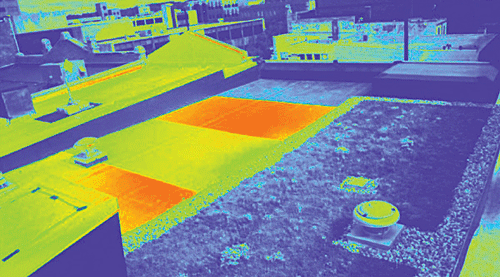 |
This thermal image illustrates the reflected solar radiation from three different cool roof surfaces on an Ann Arbor, MI rooftop. The two roof segments that appear bright orange correspond to the two most reflective products and the bright yellow segments to the somewhat less reflective product. The dark purple areas indicate the non-cool portions of the roof (or the least reflective surfaces). The original photo is found on page 6. Photo courtesy of A3C Architectural Collaborative |
Â
A Lawrence Berkeley National Laboratory study found that world-wide reflective roofing will produce a global cooling effect equivalent to offsetting 24 gigatons of CO2 over the lifetime of the roofs. This equates to $600 billion in energy savings.ii The study recommends cool roofs as a geo-engineering mechanism to counteract climate change.
CALCULATING ENERGY SAVINGS
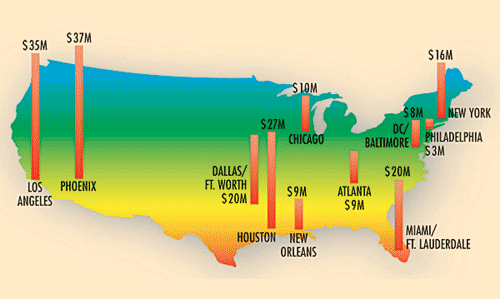 |
Nationwide implementation of cool roofs could mean an annual savings of Image courtesy of Lawrence Berkeley National Laboratory |
Â
Research by the Heat Island Group found that buildings with lightly colored, more reflective roofs use up to 40 percent less energy for cooling than buildings with darker roofs.iii To calculate the possible savings in energy provided by a cool roof, there are two online roof calculators that estimate savings.
The DOE Cool Roof Calculator was developed by the U.S. Department of Energy's Oak Ridge Laboratory. This calculator provides an estimate of cooling and heating savings for small to medium size facilities that purchase electricity with a demand charge and an alternative versionfor larger facilities. http://www.ornl.gov/sci/roofs%2Bwalls/facts/CoolCalcEnergy.htm
The EPA Cool Roof Calculator is provided by ENERGY STAR. This calculator allows the designer to input specific details about a building, including heating and cooling systems as well as location and the cost of energy. http://www.roofcalc.com/RoofCalcBuildingInput.aspx
These calculators provide a simple pay back analysis to determine the savings in electricity or natural gas through the installation of a cool roof.
The Southwest Energy
Efficiency Project (SWEEP) |
|
|
CHOOSING AND SPECIFYING A COOL ROOF:
PRODUCT RATING RESOURCES, PRODUCT TYPES, BUILDING PROGRAMS & CODES
A cool roof should be chosen based on the slope of the roof, energy savings goals, the project location and climate, local code requirement or green building credits, as well as aesthetic preferences. Designers who are seeking sustainable design credits may also want to consider the cradle-to-cradle aspects of their materials choices, including recycled content, end of life recyclability and use of toxic materials.
Once the project parameters have been established, an appropriate roofing product must be selected. Because of the environmental benefits of cool roofs, a growing number of building codes include cool roof measures. Hence, it is prudent to first check with the local or state building code to see if there are specific cool roofing requirements that must be satisfied. Such is the case with the American Society of Heating, Refrigerating and Air-Conditioning Engineers (ASHRAE) Standard 90.1, California's Building Energy Efficiency Standards, Title 24, as well as a number of city building codes, including the Cities of Chicago, Houston, and Dallas.v In addition, voluntary green building programs, such as The U.S. Green Building Council's LEED® program and the GreenGlobesâ„¢ environmental rating system, provide credit for cool roofs and several electric utility companies provide rebates.
PRODUCT RATING RESOURCES
Rated product databases can assist the designer in selecting an appropriate cool roof product because they list pertinent product information that can be easily compared. The designer can search roofing products by the initial and aged solar reflectance and thermal emittance values as well as the slope application and type of roofing material. A low-slope roof has a pitch less than or equal to 2:12. A steep-sloped roof has a pitch greater than 2:12.
While existing rating systems are complementary to one another, they do have slight differences in their requirements. ENERGY STAR, for example, aims to capture the most efficient products and set minimum requirements for both initial and aged solar reflectance. In order for a product to be listed by ENERGY STAR, it must meet their minimum requirements (initial solar reflectance of 0.65 and three-year aged value of 0.50 for low-slope products and an initial reflectance of 0.25 and aged value of 0.15 for steep-sloped products). The Cool Roof Rating Council (CRRC), on the other hand, does not set minimum requirements, but does require that all testing be conducted by a licensed CRRC Accredited Independent Testing Laboratory (AITL). The primary values of independent ratings for cool roofs are standardized and consistent test methods,
credible test results, equal subjection of products to weatherization in key climates, aged testing, and reliable product comparisons.
Both rating systems include aged testing, where products are exposed to natural weather conditions for a three-year period of time. The CRRC uses three specific locations representing three key climate zones (hot/dry, hot/humid, and cold/temperate) to determine aged product performance. ENERGY STAR accepts products that have been rated by the CRRC so long as the ratings meet ENERGY STAR's minimum requirements for both initial and aged SR/TE values. The most reliable source for solar reflectance and thermal emittance data for cool roofs is independent roofing product ratings.
PRODUCT TYPES
 |
This composite image shows only a few of the many "cool" roofing product types that are currently available in the marketplace. Clockwise from left: Photo A courtesy of GAF Materials Corporation, Photo B courtesy of Hydro-Stop, LLC., Photo C courtesy of Custom-Bilt Metals, Photo D courtesy of Decra Roofing |
Â
Materials for roofs can vary from asphalt to acrylics, and many of these products have cool roof alternatives. The following list provides examples of some common roofing product types, but does not account for every single type of roofing material in the marketplace:
Built-up Roofing (includes asphalt and coal tar pitch): Built-up Roofing (BUR) consists of built-up layers of coated asphalt and insulation applied on site and can be covered with a capsheet or field-applied coating (surfacing materials). The "cool" part of this particular roof type refers to the properties of the capsheet, typically a white mineral fiberglass surface, or coating, which are UV-resistant.
Foam Roof Systems: Field-applied foam systems are sprayed on in liquid form and harden as they set on top of the roof.
Factory-applied foam systems are formed into rigid panels and coated with a reflective coating in the factory. The foam usually gives the roof system additional insulation properties and the coatings provide the "cool" rating.
Metal: Metal roofing products can be shaped to look like shingles or shakes, or to fit unique curvatures, in addition to a typical standing seam configuration. They come in a variety of factory-applied textures and colors, including darker "cool" colors with infrared reflective pigments. Metal products can also be coated in "cool" custom colors to meet a variety of client preferences.
Modified Bitumen: Modified bitumen is bitumen (asphalt or tar) modified with plastic and layered with reinforcing materials then topped with a surfacing material. Like BURs, the radiative properties of modified bitumen are determined by the surfacing material, so a "cool" modified bitumen product will be finished off with a capsheet or coating to achieve a high solar reflectance.
Roof Coatings: Roof coatings can be divided into two categories: field-applied and factory-applied. Field-applied coatings are applied directly onto the roof surface, either on a new roof assembly or over an existing roof surface and may require an appropriate primer. Factory-applied coatings are applied directly to products at the factory prior to distribution. Examples of factory-applied coatings include coatings applied to metal, and glazes that are applied to tiles. Once applied, the coating is what determines the reflective properties of the roofing product.
Shingles, Slate, or Tile: These roofing products are commonly used for residential buildings, or steeper-sloped buildings, including some commercial buildings. For "cool" colored shingles, the heightened solar reflectance comes from granules that contain solar-reflective pigments. Slate and tile products are available with solar-reflective surfaces that increase the number of "cool" colors from which the designer can choose. Additionally, the dense, earthen composition of slate and tile products provides increased thermal mass, which yields additional energy savings that are not captured through solar reflectance and thermal emittance measurements.
Single-ply: Single-ply roofing is a pre-fabricated sheet of rubber polymers. Single-ply roofing is laid down in a single layer over a roof. The single-ply membrane can be loose-laid and weighted down with ballast or pavers or firmly set on the roof and attached with mechanical fasteners or adhesives. There are two main types of single-ply materials: single-ply thermoset and single-ply thermoplastic. These roofing products can be specified with an ultra-violet-resistant and highly reflective surface.
Aging and Maintenance
Roofs are exposed to harsh climates, solar radiation and pollution, which can reduce the solar reflectance of cool roofing materials. Lawrence Berkeley National Laboratory studied the three-year aging and weathering of cool roofing membranes made
of single-ply roofing at various locations across the United States. Results indicated that when washed with detergent, the majority of the roofs will still provide 90 percent of their un-weathered reflectance (in some cases an algaecide was required). Standard maintenance practices as suggested by the roofing manufacturer will keep your cool roof "cool" for a longer time.
BUILDING PROGRAMS AND CODES
(Please note: this section was current at the date of publication. Please make sure to check with the individual code body or program for updates.)
Increased recognition of the benefits of cool roofing has led to the adoption of cool roof measures in energy codes and the inclusion of cool roofing as part of green building initiatives.
National energy codes developed by the American Society of Heating, Refrigerating and Air-Conditioning Engineers (ASHRAE) and the International Code Council (ICC) are not mandatory regulations unless adopted by a jurisdiction as part of a regulation or law. Many states and cities have adopted either the ASHRAE or ICC codes or have adopted their own building codes. ENERGY STAR, California's Title 24, ASHRAE, LEED® and Green Globesâ„¢ are codes and programs that have all included a cool roof measure of some description.
Voluntary Green Building Programs
There are many resources from the Department of Energy to various sustainable and green design organizations which assist architects in making the right choices for green buildings. The following two programs are examples, but may not be all-inclusive:
Green Globesâ„¢
The Green Building Initiative's Green Globesâ„¢ program is a green management tool that includes an assessment protocol and a rating system and guide for integrating environmentally friendly design into both new and existing commercial buildings. Green Globes â„¢ provides credit for cool roofs as a component of their rating system.LEED
The U.S. Green Building Council's LEED® program provides certification for the energy and environmental design in the planning and construction of a building. From North Dakota to North Carolina architects are planning LEED buildings which can attain silver, gold or even platinum certification. The LEED program includes a credit for cool roofs under the sustainable sites category in recognition of the importance of urban heat island reduction.Senior architect Dave Stafford, AIA, of FourFront Design in North Dakota, designed the South Dakota National Guard Headquarters Building. This is to be a LEED Silver project and will use a standing seam metal roof in Dove Gray to meet the LEED Credit 7.2 requirements of an SRI less than 29 for a steep-sloped roof. Dave's design team learned that, "About a third of the pastel and metallic colors available for metal roofs will meet or exceed that requirement. Metal roofs are fairly popular around here - they look good, they work, they have minimal maintenance. All that was needed was a color selection with an SRI high enough to get the job done."
Recent budget evaluations, however, required the production team to replace the metal roof and the whole pitched roof structural system with a conventional flat roof. The design team can still meet the requirements for LEED Credit 7.2, which require an SRI value of 78 for low sloped roofs. The team has selected a white PVC membrane surface with an approximate SRI value of 104.
From the North to the South, LEED credits are obtainable by using cool roof systems, which are an important part of an effective energy savings strategy and environmental design.
The Joe & Joan Martin Center, Mecklenberg, SC
Cheryl Walker, FAIA, LEED AP, of Gantt Huberman Architects, PLLC, obtained the LEED® SS Credit 7.2: Heat Island Effects (Roof) for a project in Mecklenberg, South Carolina. The Joe & Joan Martin Center, also called ImaginON, received a LEED − NC® Silver rating in 2006. The roof of the large children's theater slopes from one end of the building to the other and has to accommodate huge theater and light monitors incorporated into the roof structure. The roof design combined:
• Standing seam milled aluminum used on the theater forms and light monitors, and
• A high-albedo liquid rubber polymeric membrane coating over a modified bitumen roofThe high albedo membrane made up 83 percent of the total roof area (63,100 square feet), and met both the Energy Star label requirements and the emissivity required by LEED. The spray on material is water-based, low volatile organic compound that cures to form a seamless rubber membrane. Walker notes that the liquid coating "can be used over a variety of roof types - metal, modified bitumen, hypalon, BUR, wood, concrete, and PVC - to reduce building temperatures." [See photos on page 1]
Â
Energy Codes
ASHRAE
ASHRAE standards allow designers to reduce roof insulation when a cool roof surfacing material is used on the roof. ASHRAE 90.1, the Energy Standard for Buildings Except Low-rise Residential Buildings, section 5.3.1.1, defines cool roofs as having a minimum solar reflectance of 0.70 and a minimum thermal emittance of 0.75. The 2007 version of ASHRAE 90.1 adds an alternative of achieving a minimum SRI of 82. ASHRAE 90.1 only credits cool roofs in climate zones one, two and three, based on the DOE climate zones map.viASHRAE also produces an Advanced Energy Design Guide for Small Office Buildings and an Advanced Energy Design Guide for Small Retail. These guides provide suggestions for achieving greater energy savings than standard 90.1. The guides include the use of cool roofs in climate zones one, two and three.
International Energy Conservation Code
The International Energy Conservation Code (IECC) also contains both prescriptive and performance measures for energy savings and references ASHRAE 90.1 in defining acceptable performance levels. ÂCalifornia - Title 24
Although cool roofs are not a mandatory measure for California's Building Energy Efficiency Code, Title 24, these regulations outline a clear prescription for the use of a cool roof as part of a building envelope. Under Title 24, if a cool roof is not used in situations where it is prescribed, the energy savings must be made up in another way, such as insulation with a higher thermal resistance (R-value), or windows with a lower thermal conductance (U-value), etc. Title 24 promotes energy efficiency by outlining energy standards and requiring compliance to a strict energy code. The code recognizes that cool roof surfaces can save 15 percent of the electricity needed to cool a building and that cool roofs reduce urban heat island effect and ambient air temperatures causing an improvement in air quality.A cool roof must be installed as part of prescriptive compliance to the code, or an allowed tradeoff among the building envelope components may be substituted. The performance method allows for the cool roof to set the energy budget for the proposed building. There are qualifications for conditioned and unconditioned spaces, but the main thrust of the regulations is that roof materials must obtain a third-party product rating by the Cool Roof Rating Councilvii, must be properly labeled and meet the minimum specified reflectance and emittance values set by the code. As of October 2005, Title 24 defines a cool roof for low-slope, non-residential buildings as having a minimum solar reflectance of 0.70 and a minimum thermal emittance of 0.75. As of August 2009, Title 24 includes a prescriptive requirement for steep-slope and residential buildings in certain California climate zones.
City of Chicago
The City of Chicago is one of many cities who have begun to mandate cool roofs as a way to mitigate the urban heat island effect. Chicago requires cool roofs in low-sloped roofing applications. New roofs must meet the ENERGY STAR criteria for reflective roofs.viii
REBATES AND TAX CREDITS
Because of the importance of reducing our carbon footprint and dependence on fossil fuels, there are numerous rebate programs and tax credits offered for energy efficiency measures, including cool roofing. Lists of rebate programs can be found online, as well as through local utility companies and the California Energy Commission.ix
DISPELLING MYTHS
COOL ROOFS AREN'T JUST FLAT AND WHITE:
SAVING ENERGY FROM TUCSON TO DETROIT, FROM L.A. TO D.C.
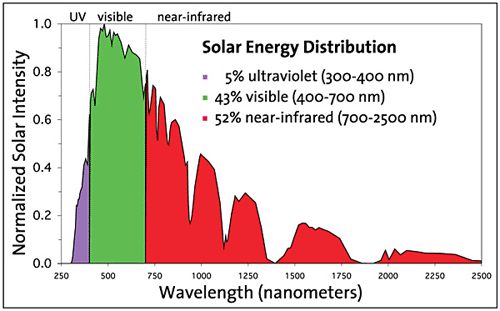 |
Solar energy distribution graph illustrating that infrared radiation makes up a large portion of the solar spectrum. Graph courtesy of Berkeley Lab Heat Island Group |
Â
Many designers believe that only white roofs meet the criteria for cool roofs, that flat or low-sloped roofs are the only ones that benefit from the specification of a cool roofing material, and that a cool roof is only beneficial in hot climates. Researchers have created a new pallet of roofing materials that combine the properties of color with reflective surface materials that challenge some of the basic assumptions of what constitutes a cool roof. Numerous roofing materials are now rated with relatively high reflectance and emittance values, including high profile products, colored products and those applicable for steep sloped roofs. This provides more choices for designers to employ aesthetic designs.
Color is made visible by light reflecting off a surface and into our eyes; however, sunlight has other properties that extend beyond the visible portion we can see. We have an intuitive understanding of the power of certain colors to reflect light as well as absorb heat, e.g., black leather seats in a convertible will be uncomfortably hot in the summer, and white clothing is a cooler choice at the beach. However, sunlight is composed of infrared and ultraviolet radiation, as well as the visible wavelengths (shown in graph above). In fact, about half of the sun's energy is infrared. "Cool color" roofing materials are created by integrating pigments that reflect infrared energy, even though their color may still absorb some of the visible spectrum. In this way, roofing products can be both "cool" and dark colored. This type of infrared reflective pigment has been used in conjunction with a variety of product types, including metal, tile, coatings and asphalt shingle granules, thus broadening the scope of cool roof applicability.
A research project by the Lawrence Berkley National Laboratory assisted manufacturers with developing new colors for cool roofing materials.x These new "cool color" products demonstrate that cool roofs don't always have to be white in order to reap the benefits of an energy-efficient roof. While the energy savings of a "cool" forest green roof will not be equivalent to that of a white or lighter colored roof, it will certainly deliver more energy savings than its traditional non-cool forest green counterpart; this is the power of infrared reflective pigments.
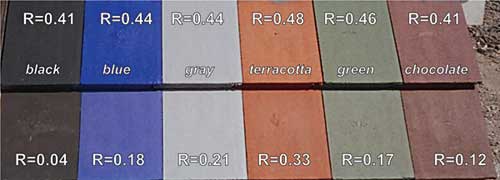 |
Advancements in pigment technology increase solar reflectance across a broad spectrum. Photo courtesy of American Rooftile Coatings |
Â
COOL ROOFS IN COOL CLIMATES
Another myth that hounds cool roofs is the notion that they should not be used in cold climates. However, there are several factors that can make cooling energy savings out weigh heating penalties in many cold climates. While more energy can be saved through the use of cool roofs in hot climates than in cold climates, there can still be advantages to specifying cool roofs in cooler climates, especially where significant air-conditioning is needed in hot summer months. In addition, it has become increasingly evident that urban heat islands exist in cool climates, and the summertime benefits of installing a cool roof may outweigh the heating penalties during winter. The energy savings calculators developed by DOE and EPA, mentioned in the "Calculating Energy Savings" section of this course, are great tools to help assess the effectiveness of a cool roof in any climate.
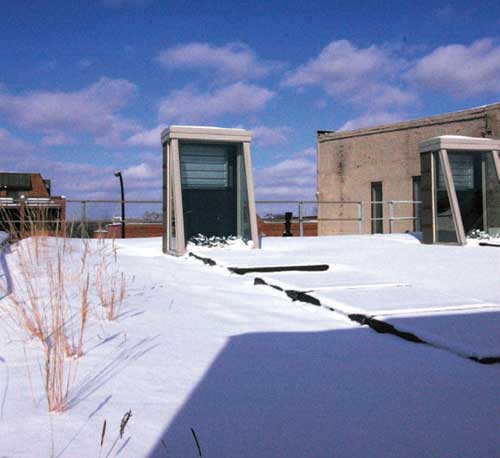 |
Heat loss through this snow covered roof in a Northern climate is no more marked by "cool" roofing than by traditional roofing. Photo courtesy of A3C Collaborative Architecture |
Â
As we all know first-hand, the sun is lower in the sky in the winter than in it is in the summer; the further north one goes, the lower it gets. Because of the shallow incoming angle, solar rays have to travel through a thicker cross-section of atmosphere during winter. As a result, the diffuse rays lose some of their potency. Additional factors that reduce the potential for heat gain during winter are that the days are shorter and there are fewer sunny days. It is also fairly typical to see snow-covered roofs in climates where a heating penalty might be a concern; this condition obviously negates any effect a roof's reflectivity may have on heat loss or gain.
Temperature Studies: Cooler than What?
Former Vice President, Al Gore, states that the planet has a fever. Studies have shown that cool roofs can be as much as sixty degrees cooler in surface temperature than non-cool roofs.xi A cool roof can reduce the temperature of a building enough to reduce the energy load. When Dan Jacobs, AIA, LEED AP, principal of A3C Collaborative Architecture of Ann Arbor, Michigan, decided to prove the advantages of a cool roof, he collaborated with Professor Motaba Navvab, Ph.D. of the University of Michigan - Taubman College of Architecture and Urban Planning Sustainable Design Research Laboratory to evaluate cool and green roof performance values.
Sustainable Design Research Laboratory, Ann Arbor, MI |
|
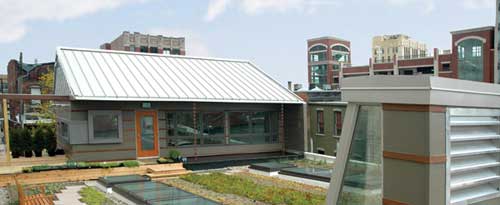 |
|
A green retreat allowed the architect to test various types of cool roofs and sustainable design strategies, including this sloped metal cool roof over the conference room. Photo courtesy of A3C Collaborative Architecture |
|
|
|
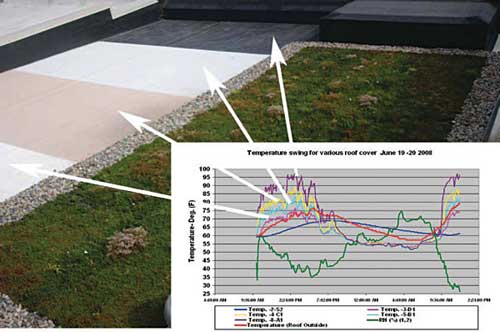
|
|
Measurements throughout the day monitored cool roof performance. Click on the diagram to view more details. Photo courtesy of A3C Collaborative Architecture |
Â
THE FUTURE COOL ROOF
Continued research and development of cool roofing materials will provide even more opportunities to mitigate urban heat islands, save energy, reduce CO2 emissions and improve air quality and occupant comfort. Additionally, new products will emerge that will broaden the range of applicability and client suitability. Cool roofs may be one of the easiest and most effective energy savings measures to implement, in both new construction and existing buildings, without compromising project design or performance.
| End Notes | |
| i | http://eetd.lbl.gov/l2m2/cool.html |
| ii | http://www.coolroofs.org/documents/IndirectBenefitsofCoolRoofs-WhyCRareWayCool.pdf |
| iii | http://eetd.lbl.gov/HeatIsland/CoolRoofs/ |
| iv | http://www.swenergy.org/casestudies/arizona/tucson_topsc.htm |
| v | http://www.coolroofs.org/codes_and_programs.html The list of city or state building codes requiring cool roofs may change from the date this article was written. |
| vi | http://www.energycodes.gov/implement/pdfs/color_map_climate_zones_Mar03.pdf |
| vii | http://www.energy.ca.gov/2005publications/CEC-400-2005-006/chapters_4q/3_Building_Envelope.pdf (Section 3.4) |
| viii | http://www.energystar.gov/ia/partners/product_specs/eligibility/roofs_elig.pdf |
| ix | http://www.consumerenergycenter.org/coolroof/faq.html#faqs-05 |
| x | http://eetdnews.lbl.gov/nl19/cool.htm |
| xi | http://www.energy.ca.gov/title24/coolroofs/ |
|

